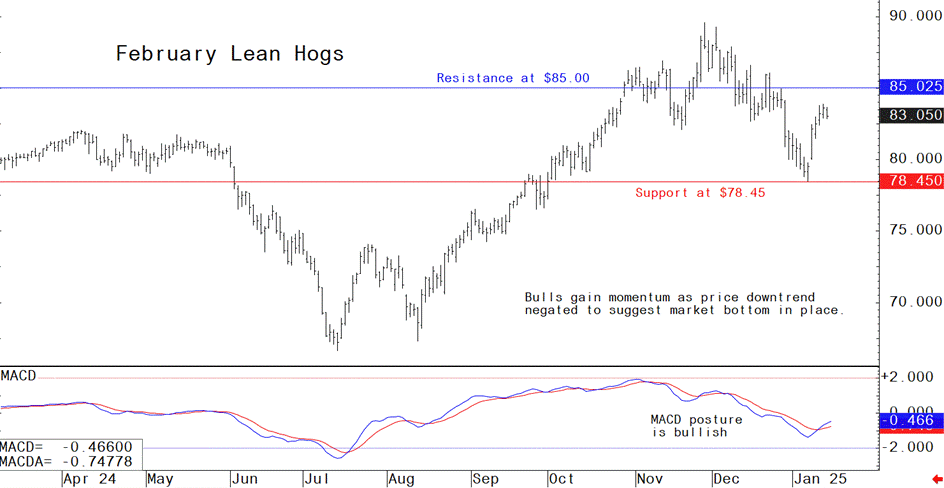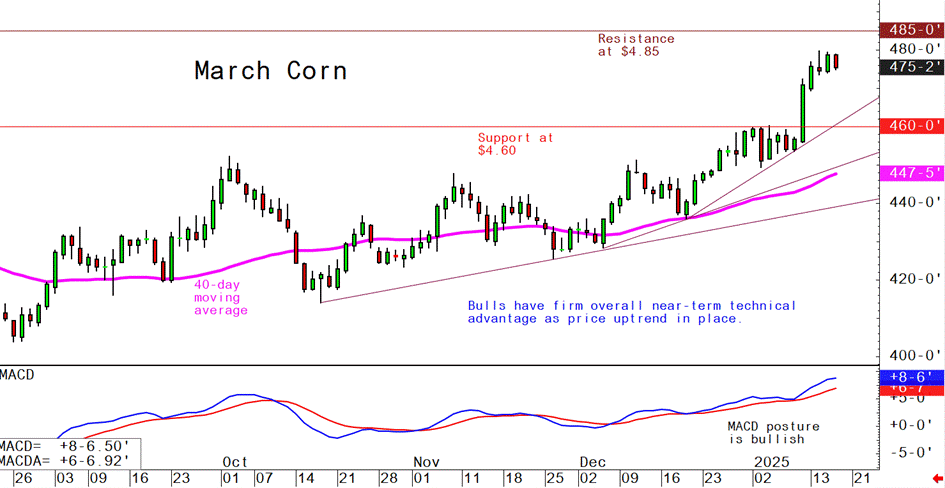



Pig outlook: Lean hog futures bulls coming to life
Livestock analyst Jim Wyckoff reports on global pig newsFebruary lean hog futures prices have seen a solid rebound the past week, to suggest a near-term market bottom is in place. A price downtrend on the daily bar chart has also been negated. The latest CME lean hog index is up 11 cents to $81.10 as of Jan. 14, the third straight daily increase. Resurgent strength in the cash market has spurred recent strength in futures. Strength in wholesale pork prices could continue to support the cash market. Retailer demand for pork remains impressive. Increased grocer prices for beef are likely driving more consumers to purchase pork.
Latest USDA and other news regarding the global pork industry
Study shows Iowa’s pork industry is a pillar of economic strength
A recent study for the Iowa Pork Producers Association highlights the pivotal role of Iowa’s pork industry in the state’s economy. As the nation’s top pork producer, Iowa contributes 33% of the U.S. hog inventory and supports over 120,000 jobs. In 2024 alone, the pork sector added $15.4 billion in economic value to Iowa, generating $8 billion in household income and $40.5 billion in total sales. The study was conducted by Decision Innovation Solutions (DIS) in 2024. Beyond economic benefits, Iowa’s pork industry emphasizes sustainability. Hog manure enriches soil, reducing reliance on synthetic fertilizers, while the use of local feedstuffs bolsters efficiency. Iowa pig farms exemplify a self-sustaining agricultural model that supports local communities and strengthens the U.S. food supply chain.
Weekly USDA US pork export sales
Pork: Net sales of 30,300 MT for 2025 were primarily for Mexico (11,700 MT, including decreases of 500 MT), South Korea (5,000 MT, including decreases of 1,100 MT), Japan (4,100 MT, including decreases of 200 MT), Canada (2,300 MT, including decreases of 600 MT), and the Dominican Republic (2,200 MT). Total net sales of 100 MT for 2026 were for Mexico. Exports of 38,200 MT were primarily to Mexico (16,300 MT), Japan (4,900 MT), China (4,000 MT), South Korea (3,900 MT), and Canada (2,300 MT).
Germany reports no new cases of foot and mouth disease
Germany has not identified any new cases of FMD, Agriculture Minister Cem Oezdemir announced, following the confirmation of the first case since 1988 in a herd of water buffalo near Berlin. Efforts are focused on controlling the outbreak, while Germany collaborates with European Union (EU) partners to maintain export markets for unaffected regions. Non-EU countries such as the U.S., Mexico, South Korea, and the UK have suspended imports of German livestock and related products as the investigation into the outbreak's origin continues.
— USDA implements import restrictions on German Animal Products in response to FMD outbreak. USDA took swift action in response to Germany's recent foot-and-mouth disease (FMD) outbreak, implementing significant import restrictions on livestock and animal products from the country.
- Livestock ban: USDA's Animal and Plant Health Inspection Service (APHIS) has prohibited the import of German cattle, sheep, swine, and goats.
- Horse import procedures: Additional measures for horses, including pre- and post-import decontamination, have been put in place.
- Processed products: Processed pork and ruminant products arriving via cargo now require either an APHIS Veterinary Services import permit or certification of treatment meeting APHIS standards.
- Unprocessed products: Imports of unprocessed animal products from Germany are now banned, with limited exceptions.
The restrictions come in the wake of Germany's first FMD case in nearly 40 years, detected in a water buffalo herd near Berlin. This outbreak has significant implications for Germany's agricultural sector and international trade.
These measures are likely to disrupt Germany's meat and dairy exports, particularly those destined for markets outside the European Union. The loss of Germany's FMD-free status under World Organization for Animal Health guidelines has already led to export challenges, with countries like South Korea imposing immediate bans on German pork imports.
USDA's actions align with standard protocols for protecting domestic livestock from potential FMD introduction, highlighting the serious economic and agricultural risks associated with the disease.
— Germany faces export disruptions due to foot-and-mouth disease outbreak. Germany’s recent foot-and-mouth disease (FMD) outbreak has disrupted its exports. South Korea, its second-largest non-EU market after the UK, has suspended German pork imports, including 360 metric tons awaiting quarantine inspection. This decision follows Korea's prior resumption of German pork imports under a regionalization agreement addressing African Swine Fever, but presently Korea does not recognize EU regionalization for FMD. Last year Korea imported about 40,000 mt of pork from Germany, representing 7% of the imported pork market. Frozen pork belly made up the vast majority of these imports. Korea has recognized Brazil’s state of Santa Catarina as FMD-free without vaccination, allowing pork imports from that state. But it took many years to reach that agreement, and access is limited to a single Brazilian state.
According to the USMEF, globally, Germany exported 1.277 million metric tons of pork in 2024 (up 18% year-over-year), with 83% to the EU, 6.5% to the UK, and 3.6% to Korea. FMD clauses in export certificates have effectively halted German pork exports to third countries, including key markets like the UK, which imported 79,400 metric tons through October.
Germany remains the EU’s second-largest pork producer, with production reaching 3.553 million metric tons (up 2% YoY). While the EU allows regionalized movement within its borders, third-country export recovery hinges on regaining FMD-free status.
The U.S. imports minimal volumes of pork from Germany, totaling 238 mt through November and consisting only of prepared pork products.
Upshot: Efforts are underway to mitigate the outbreak's effects, including targeted vaccine development to control the pathogen's spread. German authorities are working to support the agricultural sector and prevent further disruptions. This underscores the need for regionalization agreements that would negate the ability to ban from a whole country.
US pork exports stay strong in November
The US exported 643.5 million lbs. of pork in November, a record for the month and the highest monthly tally since April. Pork shipments increased 60.7 million lbs. from October and 36.4 million lbs. from year-ago. Through the first 11 months of 2024, pork exports totaled 6.469 billion lbs., up 289.3 million lbs. (4.7%) from the same period the previous year. USDA trimmed its 2024 pork export forecast by 10 million lbs. to 7.108 billion lbs., though that would be up 4.2% from 2023.
USDA made no changes to its 2025 pork and beef export forecasts. Pork shipments are expected to rise another 3.1% this year, while beef exports are projected to fall 13.4%.
China’s meat imports rise in December but fall in 2024
China imported 611,000 MT of meat in December, up 30,000 MT (5.2%) from the previous month. For 2024, China imported 6.67 MMT of meat, down 710,000 MT (9.6%) from the previous year.
USDA releases studies examining the impact of increased line speeds on worker safety in pork processing plants
Key highlights and reactions:
Study Findings
- In pork plants, 46% of 574 evaluated workers were at high risk for musculoskeletal disorders, with varied effects from increased line speeds.
- The poultry study found higher health risks for workers at plants with increased line speeds.
- The studies were conducted as part of time-limited trials allowing select plants to operate at higher speeds than the regulatory limits.
Industry reaction
- The National Pork Producers Council expressed appreciation for USDA's efforts, stating the studies provide "more certainty in an uncertain time.”
- Some industry representatives found the results reassuring, claiming they prove "higher line speeds are not a leading factor in risks to worker safety.”
Concerns and criticisms
- Labor groups have long argued that faster line speeds increase worker injury risks and could lead to serious injuries.
- Food safety advocates warn that accelerated speeds mean less time for inspectors to catch potential contamination.
- Prior to these studies, overwhelming evidence suggested faster line speeds would worsen already unsafe working conditions in poultry plants.
- The United Food and Commercial Workers International Union (UFCW), representing 1.2 million workers across North America, responded to the two USDA studies. UFCW President Marc Perrone emphasized the dangerous and demanding nature of these essential jobs and highlighted the studies' confirmation of significant worker risks, regardless of line speeds. UFCW called for robust safety measures, including better staffing, improved injury reporting, access to medical care, and ergonomic job adjustments. Perrone stressed the connection between worker safety and food safety, urging employers and government officials to prioritize protections for the workers who sustain America's food supply.
House and Senate Ag panel leaders react. Specifically:
House Ag Chairman GT Thompson (R-Pa.) and Senate Ag Chairman John Boozman (R-Ark.) issued a joint statement on the study results. They expressed satisfaction with the study outcomes, stating it was "reassuring to see independent studies proving that higher line speeds are not a leading factor in risks to worker safety in pork and poultry processing plants." They emphasized that U.S. meat and poultry companies maintain high standards for both worker safety and food safety. However, they criticized the Biden/Harris administration for allegedly overstepping the original scope of the studies, claiming it was an attempt to "villainize the industry." They indicated their readiness to collaborate with the incoming Trump administration to create long-term strategies ensuring meat and poultry companies can operate safely while maintaining production efficiency.
Regulatory implications
- USDA is using these studies to inform potential future rulemaking regarding line speed regulations.
- Current regulatory limits are 1,106 pigs per hour for pork plants and 140 birds per minute for poultry plants, with some plants allowed higher speeds under waivers.
Next steps
- USDA has extended modified line speed waivers for both poultry and pork plants to allow for further study and analysis.
- USDA Secretary Tom Vilsack emphasized the need for comprehensive data before making permanent decisions on line speeds.
Bottom line: The studies and their implications remain a contentious issue, with ongoing debate between industry interests, worker safety advocates, and regulators over the appropriate balance between productivity and worker protection.
The next week’s likely high-low price trading ranges:
February lean hog futures--$80.00 to 87.00 and with a sideways-higher bias
March soybean meal futures--$285.10 to $310.00, and with a sideways bias
March corn futures--$4.65 to $4.90 and a sideways-higher bias
Latest analytical daily charts lean hog, soybean meal and corn futures










